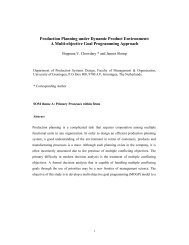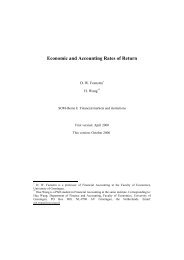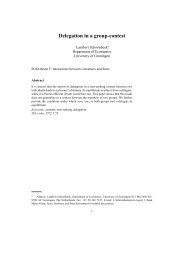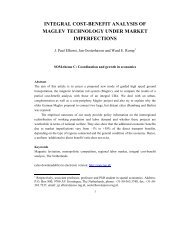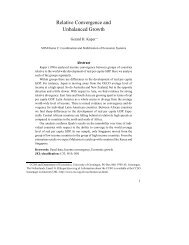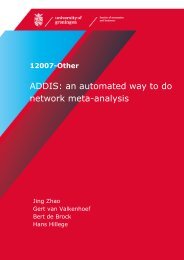Semiparametric Analysis to Estimate the Deal Effect Curve
Semiparametric Analysis to Estimate the Deal Effect Curve
Semiparametric Analysis to Estimate the Deal Effect Curve
Create successful ePaper yourself
Turn your PDF publications into a flip-book with our unique Google optimized e-Paper software.
nonparametric estima<strong>to</strong>rs, such as <strong>the</strong> k-nearest neighbor estima<strong>to</strong>r, cubic smoothing<br />
splines and orthogonal series estima<strong>to</strong>rs. Härdle (1990, pp. 77-88) shows that<br />
based on a finite-sample simulation, different methods yield essentially <strong>the</strong> same<br />
curves. Importantly, <strong>the</strong> semiparametric model we propose below requires <strong>the</strong> Kernel<br />
method.<br />
3.4 <strong>Semiparametric</strong> approach<br />
Our primary interest is in own- and cross-item deal effects, so we use a<br />
semiparametric approach that has <strong>the</strong> advantage of nonparametric regression<br />
(flexibility) for <strong>the</strong> deal variables, and <strong>the</strong> advantage of parametric regression<br />
(efficiency) for all o<strong>the</strong>r variables. We employ <strong>the</strong> semiparametric (semilinear) model<br />
proposed by Robinson (1988). We express sales as <strong>the</strong> sum of a nonparametric<br />
function of discount variables and a linear function of o<strong>the</strong>r predic<strong>to</strong>rs (almost all<br />
indica<strong>to</strong>r variables). The indica<strong>to</strong>r variables represent feature and display activities,<br />
special pack promotions, weekly effects and s<strong>to</strong>re effects.<br />
The specification of <strong>the</strong> semiparametric regression model for <strong>the</strong> estimation of <strong>the</strong><br />
deal effect curve is based on <strong>the</strong> well-known Scan*Pro model (Blattberg and Neslin<br />
1990, pp. 369-70; Foekens, Leeflang, and Wittink 1994). In Scan*Pro, <strong>the</strong> criterion<br />
variable is log unit sales (instead of unit sales) <strong>to</strong> accommodate multiplicative<br />
effects for <strong>the</strong> predic<strong>to</strong>r variables (which applies <strong>to</strong> <strong>the</strong> semiparametric model in its<br />
parametric part). The price variables are log price indices. The price index is <strong>the</strong><br />
ratio of actual price for an item relative <strong>to</strong> its regular price. Price indices less than<br />
one represent temporary price cuts. The usage of price indices allows us <strong>to</strong> isolate<br />
<strong>the</strong> deal effects and it enhances <strong>the</strong> comparability of (deal) effects across items and<br />
product categories.<br />
We do not include regular prices as predic<strong>to</strong>rs in our model. The regular prices tend<br />
<strong>to</strong> be collinear with s<strong>to</strong>re indica<strong>to</strong>r variables, because <strong>the</strong>y vary especially across<br />
s<strong>to</strong>res. Over time, almost all changes in regular prices occur in <strong>the</strong> same week(s)<br />
in all s<strong>to</strong>res within each chain we use for analysis. Therefore, <strong>the</strong> weekly indica<strong>to</strong>r<br />
variables capture such effects adequately, and <strong>the</strong>re is no missing variable bias5 due<br />
<strong>to</strong> <strong>the</strong> exclusion of regular prices.<br />
5 To study this conjecture we also included regular price effects in all three models for all three<br />
product categories. The estimation results showed that <strong>the</strong>re were no noticeable changes in <strong>the</strong> shapes<br />
of <strong>the</strong> deal effect curves. The fit- and predictive validity statistics improved slightly, but <strong>the</strong> relative<br />
performances of <strong>the</strong> models stayed <strong>the</strong> same. The estimated regular price elasticities, however, had<br />
wrong signs and unexpected magnitudes in some cases as a result of a high degree of multicollinearity.<br />
8



